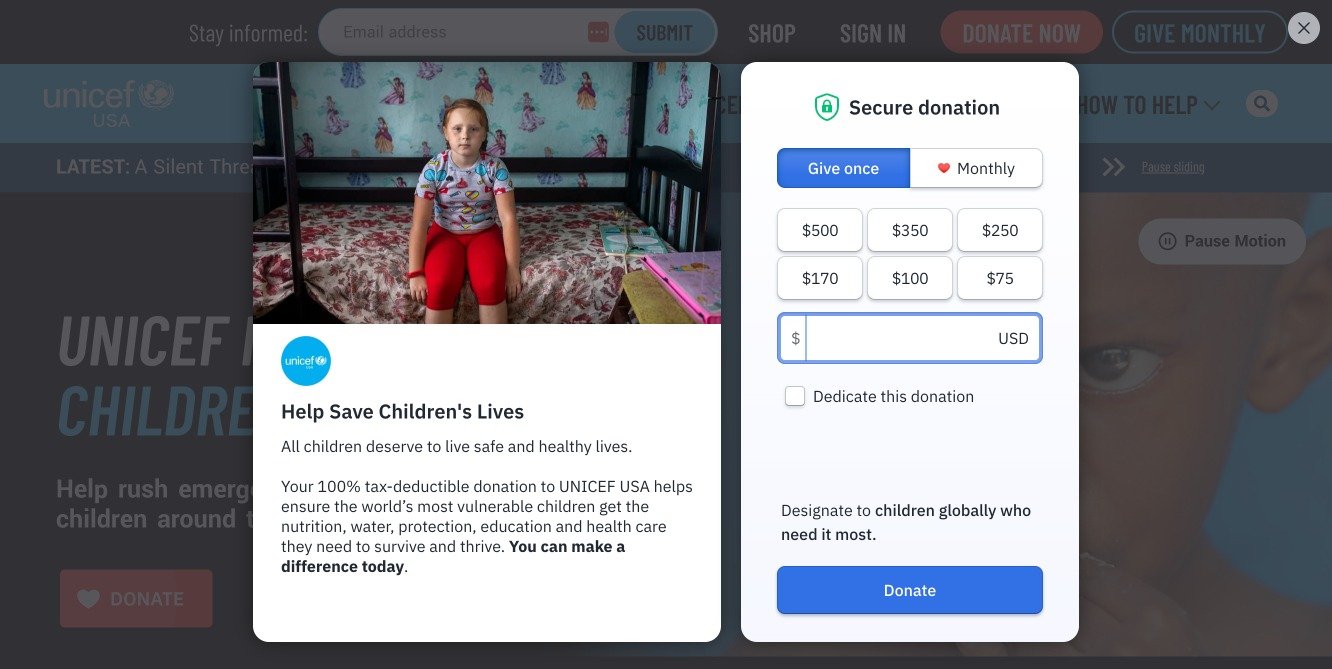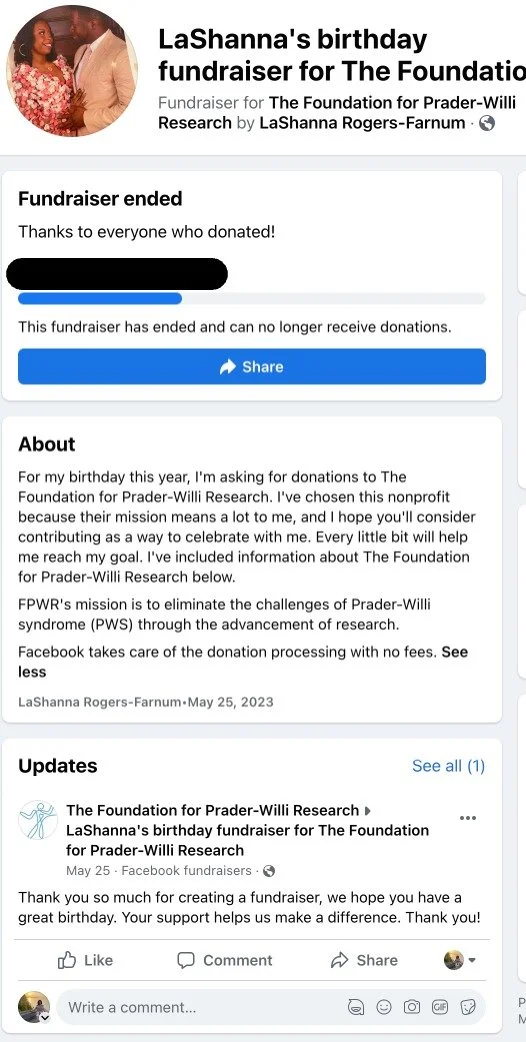How to Find Donors for Your Nonprofit
Maintaining a steady flow of funding is necessary for carrying out your mission and creating a positive impact in your community. You’ve heard this from me before: A nonprofit should have at least 10 revenue streams. Among these, donors play a pivotal role. They provide much-needed financial support and contribute to your sustainability and growth.
More than 69% of revenue to nonprofits is generated from individual donors. Understanding the significance of donors and learning how to effectively connect with them is key to securing the necessary resources for your nonprofit's success.
Consider this: Americans gave $557.16 billion in 2023! This mind-boggling number shows the immense potential for giving. However, many nonprofits struggle to identify and engage with potential donors. If you’re unsure where to find potential donors or face difficulties establishing meaningful connections with them, you are missing out on a viable funding stream.
And if you’re struggling to find donors to support your organization, here are some strategies and insights to help you discover and approach potential donors for your nonprofit. No matter the size of your nonprofit, you can learn to attract and retain donors effectively.
Crystalize Your Nonprofit's Mission, Impact, and Needs
Understand the Donor Landscape
How to Find Donors for Your Nonprofit: 15 Effective Strategies
1. Enhance your website’s user experience
2. Convert visitors into subscribers and regularly connect
3. Promote multiple donation options
4. Foster supporter advocacy
5. Leverage your board member networks
6. Form strategic alliances
7. Participate in public events
8. Host impactful in-person events
9. Secure speaking opportunities
10. Cultivate a vibrant social media community
11. Create an informative blog
12. Pitch stories to local media
13. Encourage donor gift matching
14. Emphasize impact with hard numbers
15. Use paid advertising
Where to Find Donors for Nonprofits
FAQ (Frequently Asked Questions)
1. How do I find donors for my project?
2. How do you approach a donor?
3. Where can I ask for donations online?
4. Can nonprofits give gifts to donors?
5. Do nonprofits have to disclose donors?
Find Donors for Your Nonprofit
Crystalize Your Nonprofit's Mission, Impact, and Needs
Before you even begin looking for donors for your organization, you must clearly explain your nonprofit's mission and specific goals. Define the core purpose and values that drive your organization's existence. Ask yourself fundamental questions, such as:
Who is our primary target audience? Funders don’t fund organizations that serve everybody. The resources are spread too thin, and the organization is not seen as a subject matter expert.
What will change as a direct result of our program(s) or service(s)? What will increase or decrease (this is where funders determine the measurable return on their investment)?
How is what we’re doing different from what our competitors are doing? What makes your programs innovative?
Are we making an impact on our community? Can you quantify your impact? What is your track record? This is what funders will look to fund, the quantifiable impact (How many students have graduated? How many clients have learned livable wage skills? How many seniors have improved their overall health?)
A well-defined mission statement serves as a compass, ensuring your actions and decisions are in alignment with your nonprofit's purpose. It will also make it easier to articulate your goals and values to potential donors seeking to support causes that resonate with their philanthropic interests.
Highlight the positive impact your organization has on your clients.
Donors are motivated by the desire to make a difference and see tangible results from their contributions. As you seek new supporters, emphasize the positive impact your nonprofit has had or intends to have on your community. Share stories, testimonials, and concrete examples of how your organization's work has transformed lives, empowered communities, or driven positive change.
Use data and evidence to demonstrate the efficacy of your programs and the extent of the impact you have achieved (e.g., Over 80% of our program participants go on to secure a living wage job after completing the project). Showing potential donors the real-world outcomes of their potential support can be a powerful motivating factor for them to get involved.
Create a compelling case for support to justify the need.
Craft a compelling case for support that communicates why your nonprofit's work is necessary and worthy of funding. Outline the unique strengths and differentiators that set your organization apart from others in the same space (e.g., the delivery method, the staff with lived experience delivering the program, the culturally-based curriculum, where you administer the program). Focus on how the innovative approaches you use to tackle the problems increase your success rate.
People want to back a winner, not a dying organization.
In your case for support, clearly state your organization's financial needs and how you will use donor contributions to further your mission. Demonstrate how their support will create opportunities, not temporarily keep afloat a sinking ship. Don’t go the doom and gloom route. Don’t say, “If we don’t get your support, we will have to close our doors.” Instead, say, “Your donation will allow Anna (and other girls like her) to be exposed to mentors, and nontraditional careers and gain new skills.”
Be transparent about where their money will go. Make sure donors understand the direct impact it will have. Be specific, like the example above, versus, “every dollar goes to support programs and services that help create bright futures for our youth.” This transparency builds trust and confidence in potential donors, assuring them that their contributions will be put to good use.
Understand the Donor Landscape
Once you’ve got a solid case to present to donors, it’s time to find them.
First, identify your ideal donors.
Research potential donors to gain insights into what drives their philanthropic giving. Look into demographics to create a comprehensive profile:
Age (Which age group gives most to your type of cause?)
Profession (What type of professionals gives most to organizations like yours?)
Income levels
Segment your donors based on their interests, values, and past giving history. For instance, some donors may be more passionate about education-related causes, while others may focus on environmental conservation. Some make focus on youth, while others focus on seniors. Tailoring your approach to each segment can lead to more meaningful connections and higher engagement, which helps you gain new donors.
Understanding the giving capacity of your target audience is equally important. Some donors may have the financial means to make significant contributions (i.e., $50,000 + potential major donors), while others may prefer smaller ($100/month), recurring donations. Assessing new contacts' engagement levels will help you design fundraising strategies catering to their preferences and abilities.
Review metrics over the past year. For example:
The articles they read (and donated to) in your newsletter (to determine areas of interest)
How much and which programs they donated to
Events they attended or volunteered to support
Your email marketing/social media/website platforms have a metrics section that will reveal the level/topics of engagement by your viewers. Add this information to your donor profiles.
So you have your ideal donor profile. Next, analyze past donors to understand their giving preferences. Doing this gives you insights into the types of individuals or organizations that support your mission.
Did certain donors from a specific demographic tend to contribute more frequently?
Were there specific campaigns or initiatives that resonated particularly well with donors?
Understanding what has worked in the past can guide your future outreach efforts and help you target the most promising donor prospects. This also helps save time and money. Do more of what works, less of what doesn’t. The only way to accurately figure this out is to review the data.
“Do more of what works, less of what doesn’t. ”
Go one step further and reach out to your past donors to solicit feedback to discuss what programs they might be excited about supporting, and at what level. You can ask the donor, "How do you like to be approached for potential support?" Donors are typically quite honest. Some will say, I like a formal request (e.g., proposal, description of the program, requested amount. Some like to tell you what they want to fund and at what level. Some like to see the programs in action, talk to the participants, and decide based on that. This will be useful in refining your approach and identifying areas for improvement.
Foster a relationship with donors. Invite the donor to lunch. Talk to them—don't pitch them. Get a sense of what they like, what they don't like.
Follow up with a few programs for them to review. Once they decide which they like, invite them to witness the program in action with an in-person site visit.
Send them photos, swag, newspaper clippings, journal entries, and videos.
Follow up with another request to discuss the program. Ask for support directly.
By fostering a relationship with past donors, you may also encourage them to become repeat contributors or advocates for your cause, extending your reach to new potential supporters.
How to Find Donors for Your Nonprofit: 15 Effective Strategies
You’ve got a solid case for support. You’ve identified your potential new donors. Time to roll up your sleeves and implement strategies to connect with those donors. Here are 15 things you can do to find donors for your nonprofit organization.
1. Enhance your website’s user experience
The first thing a person (donors included) is going to do is google your organization. A user-friendly website with clear navigation and compelling content can significantly increase donor engagement and encourage visitors to take action. Your mission and impact should be on the home page. Your donate button should stand out at the top right side of your navigation bar, and contact information should be easy to find.
Make sure you include:
An email to a person, not info@ or support@–donors want to contact people
A Physical address, not a PO Box! Public charities should be accessible
Furthermore, ensure that your website is mobile-responsive. There are 310 million smartphone users in the United States, and an increasing number of donors access information and make contributions on their mobile devices.
Note, though, that unless you have web development experience and have built your site yourself, the easiest way to ensure the proper implementation of this strategy is to let your web developer/administrator take care of it. Don’t cut costs with your website; an unprofessional representation of your organization could cost you donations.
2 . Convert visitors into subscribers and regularly connect
You can offer incentives to convert website visitors into subscribers in exchange for their email addresses. One effective way to do this is by providing a newsletter with interesting content related to your nonprofit's mission and impact.
When visitors sign up for the newsletter, you get their email addresses, and you can use this list to keep them engaged and informed about your organization's activities—showcase your initiatives and achievements. Over time, some of these subscribers may be inspired to become donors. Use metrics to determine donor interest and create specific campaigns to entice subscribers into supporting your cause financially.
Related reading: Why Every Nonprofit Needs an Email List
3. Promote multiple donation options
Multiple donation options are essential for maximizing donor participation and engagement. This includes providing options for one-time donations, allowing individuals to make a single contribution at their convenience. Offer multiple giving levels (e.g., $25, $50, $100).
Additionally, offer monthly recurring giving options, enabling donors to set up automatic, regular donations, spreading their support over time. Look at how UNICEF does this.
In-kind contributions should also be highlighted, encouraging donors to donate goods or services that can directly benefit your organization's mission (e.g., paper, gift cards, accounting services, vehicles, furniture, etc.).
By doing this, you make it easier for donors to contribute in ways that align with their personal preferences and financial capacity.
4. Foster supporter advocacy
Encourage existing supporters to become enthusiastic advocates and spread the word about your cause. Some ways to do this:
Host supporter appreciation events
Feature supporter stories on social media
Offer exclusive volunteer opportunities
Create a shareable hashtag campaign
Provide branded advocacy materials
Organize peer-to-peer fundraising campaigns
Engage supporters through online forums
Start a supporter ambassador program
5. Leverage your board member networks
Utilize the influence and connections of your board members to reach out to potential donors. Fundraising is a part of the Board’s fiduciary responsibility. If you’ve been following me for a while, you know I say don’t stack your board with friends, family, roommates, and co-workers. You need experienced, professional people who have their own networks. Networks that serve as potential donor pools (among other things).
6. Form strategic alliances
Partner with like-minded organizations and businesses to expand your donor network and increase your impact.
For example, if you are an environmental nonprofit, partner with an eco-friendly company by hosting joint events and cross-promoting each other's work. This partnership not only increases your visibility to the company's customers but also introduces the business’ employees and stakeholders to your cause.
As a result, you both benefit from a broader donor network, increased support, and a more significant collective impact on environmental conservation efforts in your community. It’s a win-win!
7. Participate in public events
Increase your brand visibility, raise awareness, network, and advocate for your organization by actively participating in relevant public events.
Say your nonprofit is dedicated to animal welfare. Why not participate in a community pet adoption fair? Set up a booth showcasing your rescue animals and educational materials about responsible pet ownership. By engaging with the public at the event, you raise awareness about your cause, introduce the community to your organization, and connect with animal lovers who may be interested in supporting your initiatives.
8. Host impactful in-person events
Organize fundraising events to connect with potential donors in person, as well as garner support.
For example, if you’re a nonprofit providing education opportunities for children from underresourced communities, plan an event to encourage donors to participate.
You can host a gala fundraising event and invite community members, local businesses, and influential individuals to attend. During the gala, feature success stories of children who have benefited from your programs, emphasizing the transformative impact of education.
You create personal connections with attendees through the event, fostering a deeper understanding of your mission and encouraging donations. The impactful in-person event not only raises significant funds but also cultivates a network of committed supporters invested in your cause.
9. Secure speaking opportunities
Share your nonprofit's inspiring story and achievements at events and conferences to attract potential donors.
You can take two main approaches to secure speaking opportunities at events and conferences. First, leverage your existing network by reaching out to contacts, board members, and supporters to explore potential speaking engagements. They might have connections or insights that could lead to valuable opportunities.
Secondly, actively network at industry-related events and gatherings. Attend conferences, workshops, and other events related to your nonprofit's mission and field. Engaging with event organizers and potential partners in person can build relationships and increase your chances of being invited to speak at future events.
Once you've had the opportunity to speak at events, it's crucial to follow up with interested attendees. Take the time to engage with them further, providing additional information, answering questions, and expressing gratitude for their interest. By nurturing these connections, you can transform these relationships into potential donors, ultimately strengthening your nonprofit's impact and outreach.
10. Cultivate a vibrant social media community
Actively interact on social media platforms to build a passionate community and attract potential donors.
Chances are you’re familiar with birthday fundraisers on Facebook—when people ask their friends to donate to a specific cause in lieu of a traditional birthday gift. In the example below, the nonprofit (Foundation for Prader-Willi Research) went one step further by highlighting the supporter who created the Facebook fundraiser.
11. Create an informative blog
Publish valuable and engaging content on your website to attract more visitors and connect them with your mission. This encourages potential donors and supporters to get involved.
Doctors Without Borders’ blog is an excellent example of using storytelling to keep its audience involved. While it’s not called a “blog,” the page is updated regularly with news and stories highlighting how the organization works to achieve its mission.
12. Pitch stories to local media
Reach out to local media outlets to raise awareness and get visibility. Share compelling narratives and success stories to inspire the local community and attract potential donors and volunteers.
How do you find local media to pitch to?
13. Encourage donor gift matching
Motivate donors by offering matching opportunities to multiply the impact of their contributions.
Provide an incentive for donors to contribute by offering to match their donations. When a donor makes a contribution, you pledge to match a certain portion or the entire gift amount. This strategy motivates donors to give more because their contribution effectively doubles in impact, making their support go even further.
14. Emphasize impact with hard numbers
Present tangible success metrics and quantifiable outcomes to reinforce the significance of donor support.
Say you’re a health-focused nonprofit. In your annual report, on your website, or in a newsletter article, highlight that your vaccination campaign reached 10,000 children, resulting in a 25% decrease in preventable diseases in target communities.
Additionally, share how your nutrition initiative improved the overall health of 5,000 families, leading to a 30% decrease in malnutrition rates. Go one step further and say you have a waitlist of 500 families.
By presenting these quantifiable outcomes, you reinforce the significance of donor support, demonstrating that every contribution directly contributes to measurable and life-changing results and incentivizing donors to give.
15. Use paid advertising
Using paid advertising means investing in online ads to expand your reach and find new donors. You’ve seen these ads on Facebook, Twitter, Instagram, and Google search results. Paid advertising gets you in front of people who may not normally find you, but it’s important to measure the ROI. The good news is that you can include this expense in your budget. Here is a guide to paid advertising for nonprofits.
Successful donor acquisition involves a balanced approach that combines digital and real-world efforts. Build a relationship with your donors (and nurture it), articulate the value of your nonprofit's work, and persistently pursue your fundraising goals.
Where to Find Donors for Nonprofits
Here’s a “cheat sheet” to help you find new donors.
Individual Donors
Existing donors: Cultivate relationships with current donors to encourage recurring support and referrals.
Personal networks: Tap into your board members, staff, volunteers, and supporters' networks for potential donors.
Major donors: Find major donors by researching and reaching out to individuals with the capacity to make significant contributions.
Corporate Donors
Local businesses: Approach businesses in your community looking for marketing opportunities. Supporting a nonprofit is great for their brand, and receiving a tax benefit is a great incentive.
Corporate Social Responsibility (CSR) programs: Look for companies with CSR initiatives that align with your nonprofit’s mission. Check their website for how to apply for support.
Employee giving programs: Register your organization for workplace giving programs to receive monthly donations from employees of corporations and government agencies. Introduce them to your organization. This may lead to long-term and larger donations.
Online Fundraising Platforms/Online Donation Campaigns
Crowdfunding websites: Use platforms like Kickstarter, Indiegogo, or GoFundMe to design giving campaigns and reach a broader audience.
Nonprofit fundraising platforms: Utilize platforms like Donorbox, Classy, or Network for Good to create SMS/Text, peer-to-peer, and event campaigns and to collect online donations.
Giving Tuesday: Develop an end-of-year giving campaign for the annual Giving Tuesday day for donating to nonprofits to attract donors during the giving season.
Year-end giving: Launch year-end campaigns to capitalize on the holiday spirit of giving.
Tax season: Develop a special campaign for individuals and businesses looking for last-minute tax write-offs before they file their annual tax returns. Launch it in February and March to attract donors to give.
Check out this resource: What is the best online donation platform for nonprofits?
Social Media
Facebook fundraising: Set up a Facebook fundraiser and share it with your followers and supporters.
Twitter, Instagram, and LinkedIn: Use these platforms to share your nonprofit's mission, impact stories, and donation links.
Read this essential guide to social media for nonprofits.
Community and Civic Organizations
Local clubs and associations: Partner with community groups and clubs interested in your nonprofit's area of focus.
Rotary Clubs, Lions Club, etc.: Engage with civic organizations that often support charitable causes.
Alumni and Educational Institutions
Engage alumni: Connect with former volunteers or participants to support your cause.
Approach educational institutions: Seek support from schools, colleges, and universities with an interest in your cause.

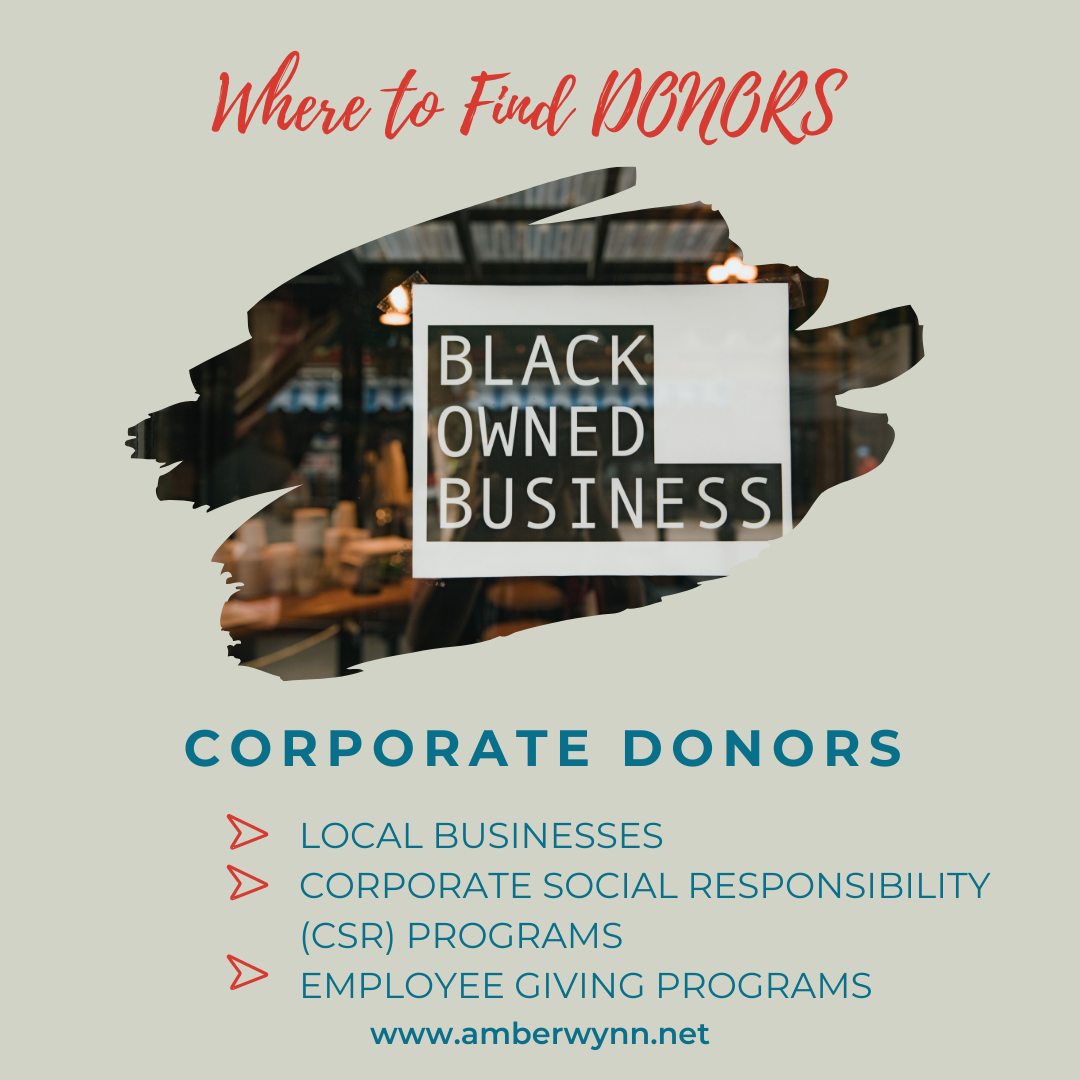
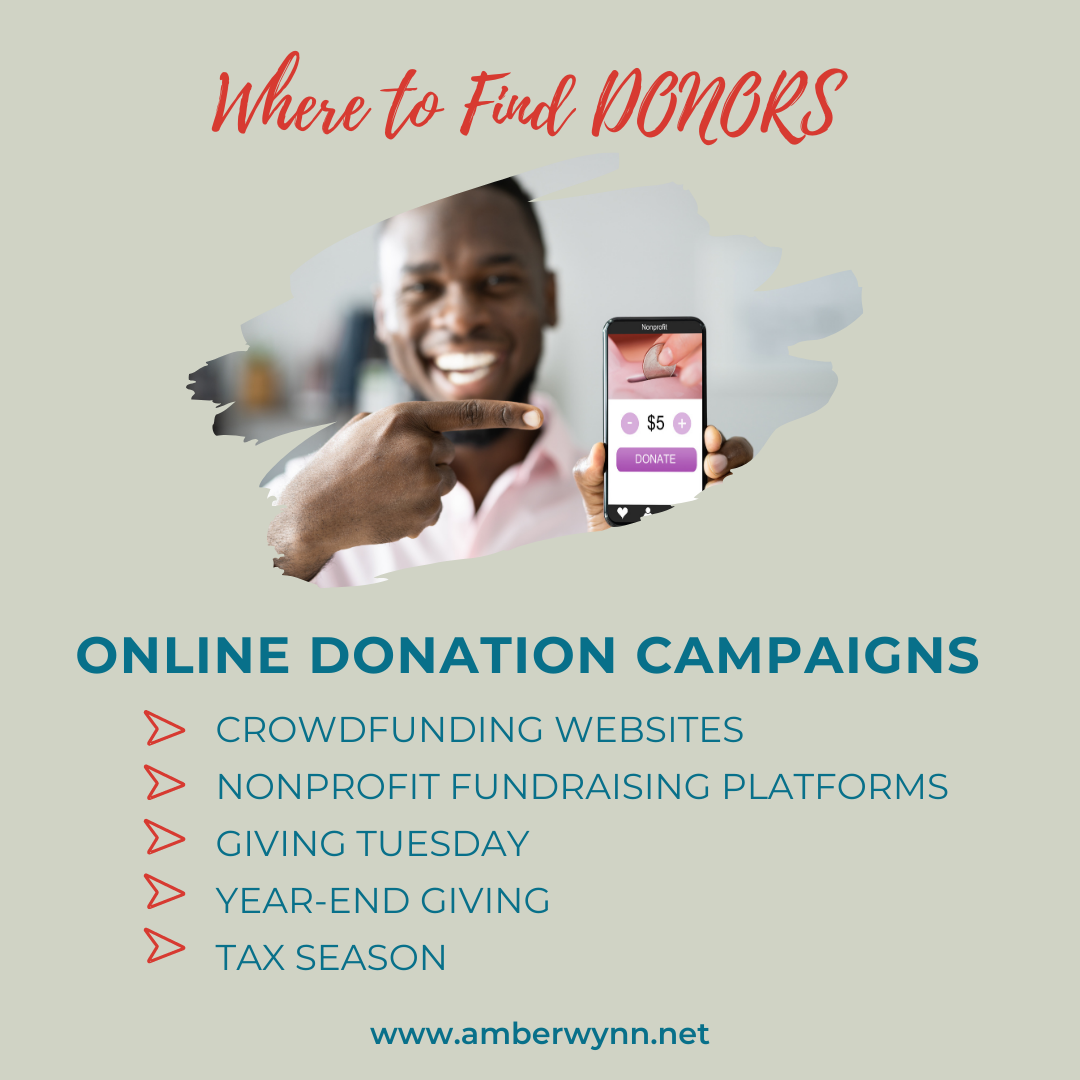
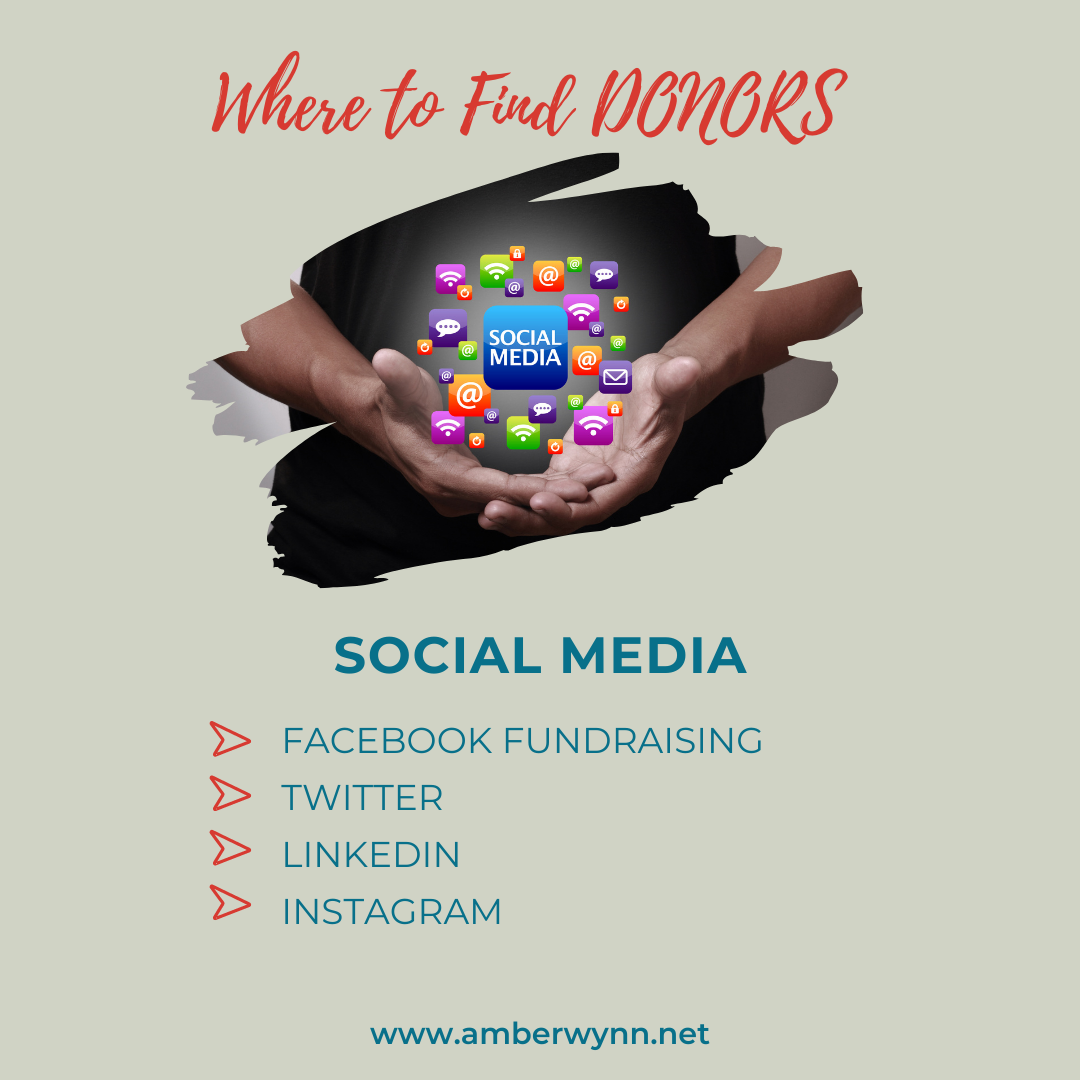
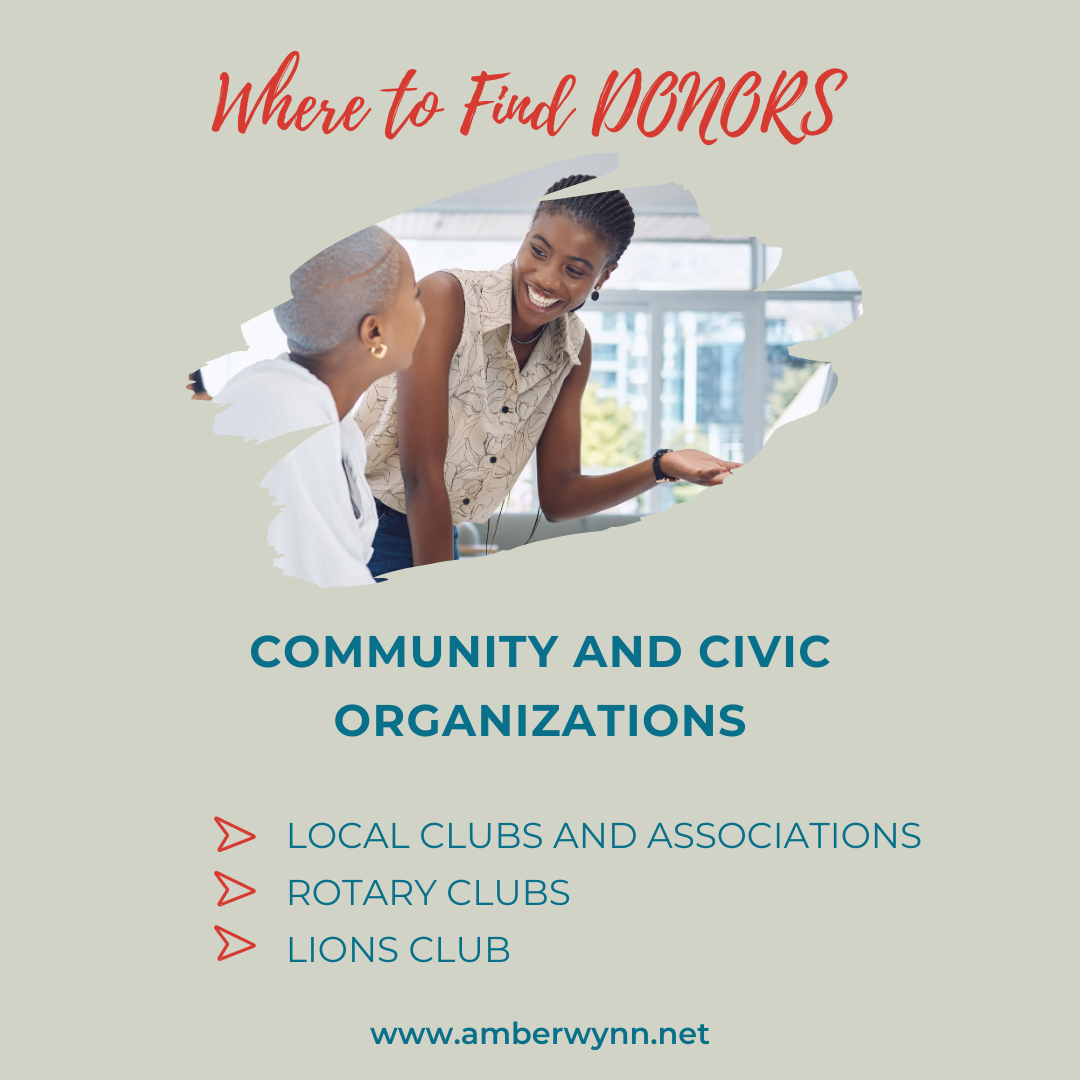
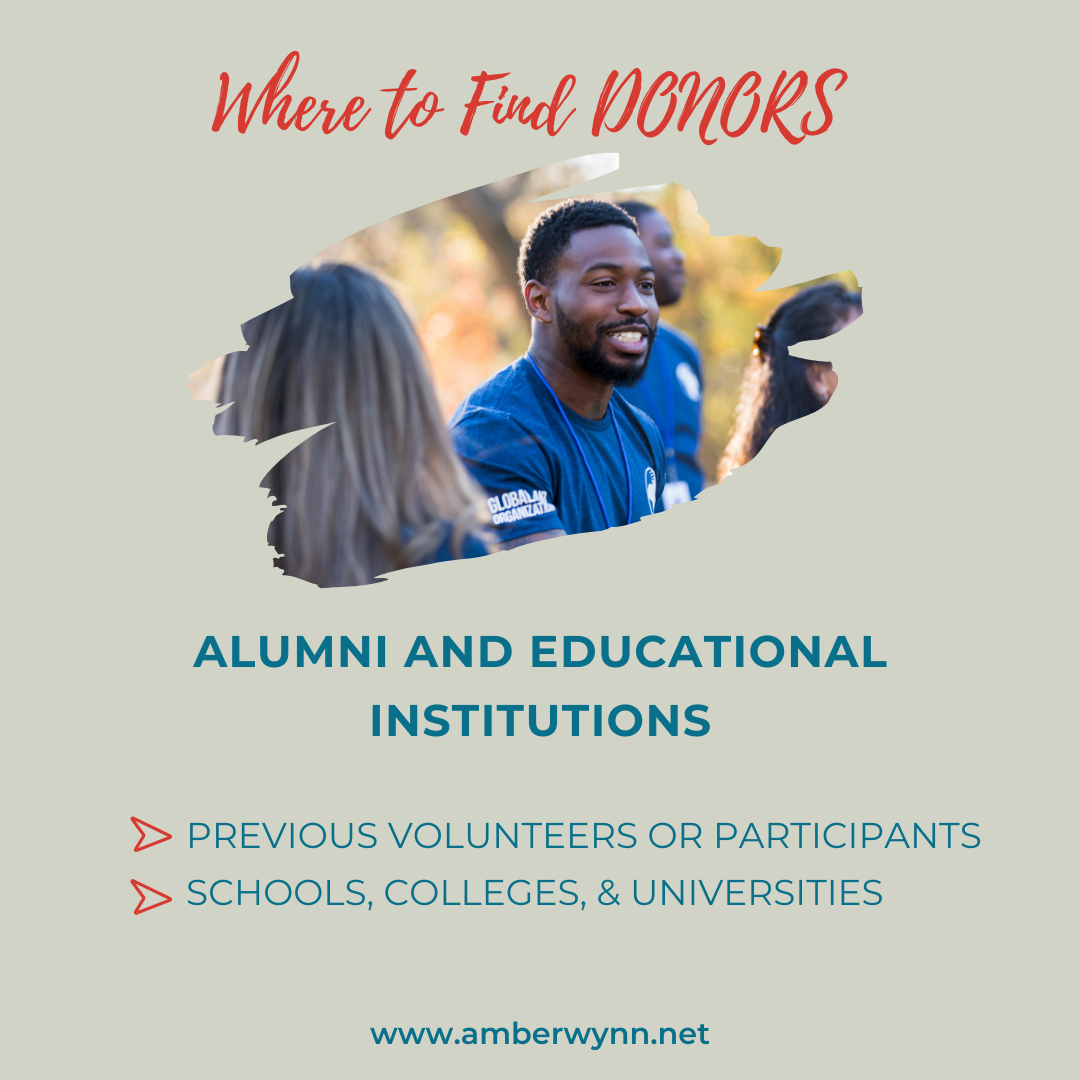
Finding donors is an ongoing process. It's essential to build and nurture relationships, maintain transparency, and show gratitude to donors to foster a supportive community around your nonprofit's mission.
It doesn’t have to be grand gestures, simple things go a long way:
Invite them to events
Offer volunteer opportunities
Interview them and feature them on your website or in your newsletter
Meet with them at least once a year
Provide them with regular updates (newsletters, annual reports)
Send handwritten thank you notes for donations (e.g., have participants send handwritten thank you notes, photos, or handmade gifts of appreciation)
Give them merch
Honor them during special events
Name an award in their honor
To maintain transparency, post your 990 on Guidestar. Provide donors with annual reports: include metrics, challenges, successes, and financial statements.
FAQ (Frequently Asked Questions)
1. How do I find donors for my project?
To find donors for your project, start by crystalizing your project's purpose and impact. Conduct research to identify prospective donors. Tell a compelling story to engage donors emotionally. Utilize online platforms, network, and offer incentives in exchange for emails. Communicate the project's quantifiable impact and need.
2. How do you approach a donor?
When approaching donors, focus on building relationships. Clearly communicate your organization's mission, impact, and goals. Develop an accurate annual organization and program budget. Tailor your message to align with the donor's interests. Engage in personalized communication, and be transparent about how their contributions make a difference.
3. Where can I ask for donations online?
You can ask for donations online through your nonprofit's website, crowdfunding platforms like GoFundMe, social media channels, email campaigns, newsletter, virtual fundraising events, giving portals, corporate giving websites, and peer-to-peer fundraising. These online avenues allow you to reach a wider audience and engage potential donors effectively.
4. Can nonprofits give gifts to donors?
Nonprofits can give gifts to donors, but it's important to consider how it represents the organization. Nonprofits should always steward resources. Gift giving could be misconstrued as wasting money that could be allocated to programs. Gifts should be token items of appreciation, not excessive presents. Verify donors’ preferences—some may not want to receive gifts. These preferences are typically noted in agreement/award letters. If it is not, call your program officer to confirm.
A good practice is to give gifts that are products of your programs. For example, handmade arts and crafts created by program participants—you can give their work to donors as tokens of appreciation. Focus on expressing gratitude to donors while stewarding resources.
5. Do nonprofits have to disclose donors?
Nonprofits are public charities; the IRS requires all U.S. tax-exempt nonprofits to make public their three most recent Form 990 or 990-PF annual returns (commonly called "990s") and all related supporting documents.
Although the federal government does not generally require nonprofits to disclose their donors, some states do. For instance, at least five states (California, Hawaii, Kentucky, Mississippi, and New York) require a nonprofit to submit an unredacted Schedule B in order to remain registered as a charitable organization.
However, some laws provide donor anonymity protection. Always consult tax experts and local, state, and federal authorities to adhere to the specific disclosure requirements for your nonprofit.
Find Donors for Your Nonprofit
Finding donors for your nonprofit is crucial in ensuring your organization's sustainability and success. With a well-defined mission, compelling storytelling, and a strategic approach to engage potential donors, you can build a network of supporters who are passionate about your cause.
Utilize online platforms, participate in community events, and leverage your existing networks to connect with donors effectively. Remember to maintain transparency, exercise donor stewardship, and show gratitude to foster a supportive community around your mission.
Ready to take the next step in finding donors? Start implementing these strategies today.
Do you want to make your fundraising efforts more effective? Engage in donor-centric fundraising.





